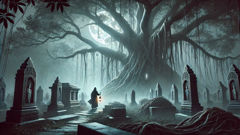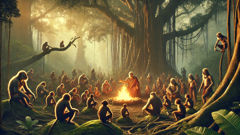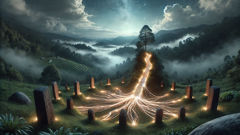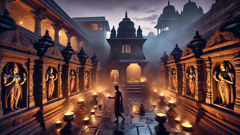Introduction
Long ago, nestled between emerald mountains and ancient pines, there stood a quiet village in the heart of China. Life here followed the slow, steady rhythm of the seasons: rice paddies shimmered under the spring sun, bamboo forests whispered in the summer breeze, and in winter, snow dusted rooftops and turned the world soft and silent. But there was a time of year when the villagers’ hearts pounded with dread, for legend told of a monster—a beast called Nian—that descended from its hidden lair at the edge of the world every New Year’s Eve. With jaws like stone gates and eyes that burned like fire, Nian was said to sweep through the valley, devouring crops, livestock, and sometimes, if luck ran cold, even those too feeble or slow to hide. Generations grew up listening to tales of Nian’s fearsome rampages. Every winter, before the moon grew fat and round, families shuttered their windows, children were hushed, and the village would seem to shrink beneath the weight of fear. Yet, as stories often do, the legend of Nian did more than frighten; it sowed seeds of courage, unity, and a spark of defiance. For within these mountains, people learned not only to survive but to find hope in the darkest nights. The tale of how this hope grew—of cleverness outwitting terror, of red banners fluttering against the snow, and of joyous explosions that lit up the night sky—lies at the heart of every Chinese New Year celebration. This is the legend of Nian, and how a humble village changed its fate, forever transforming fear into festivity.
A Night of Terror: The Coming of Nian
The villagers of Xiyuan had always marked time by the phases of the moon and the creak of bamboo in the wind. Yet, nothing filled their calendar with more apprehension than the last day of the lunar year. In the days leading up to it, children gathered around the fireside, listening with wide eyes as elders described the monstrous form of Nian—a creature as old as the mountains, with scales like iron, teeth sharp as jade daggers, and a mane that shimmered with frost. Some said its roar could split stone. Others whispered that it could vanish into mist, reappearing wherever fear was strongest.
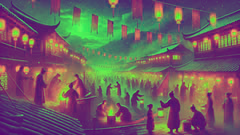
As the final night approached, the village transformed. Doors were reinforced with thick planks, windows stuffed with straw. Livestock were herded into the deepest cellars, and every household stockpiled dried fruits and rice cakes. It was on such a night, when winter’s chill bit hardest, that a boy named Wei couldn’t sleep. He pressed his face to the frosty window, watching as his father placed a wooden bar across the door. His mother worked beside the hearth, her hands shaking only slightly as she prepared sticky rice dumplings for their midnight meal—a tradition meant to draw the family close and keep spirits high.
In the shadowy corners of the village, an old woman named Granny Lin shuffled from house to house. Wrinkled but spry, with eyes bright as black pearls, she carried a battered lantern and whispered words of comfort to those who dared open their doors. Though she’d survived more Nian attacks than anyone could remember, she never lost her wry humor. Some claimed Granny Lin was as stubborn as Nian itself.
On this particular New Year’s Eve, the air felt different. The wind howled like a chorus of wolves, shaking the bamboo groves and sending the lanterns dancing. Deep in the forest, a sound rumbled—at first so low that only the village dogs pricked up their ears. Then it grew, rolling down the mountainside: a growl that seemed to claw at the roots of every tree. Wei’s heart hammered in his chest. Suddenly, a blaze of white eyes flickered between the pines, and the ancient fear became real. Nian had come.
The beast’s arrival was chaos. With a roar that rattled every bone in the village, Nian surged from the darkness. Its scales reflected moonlight, and every footstep left a crater in the snow. The bravest men beat gongs and lit torches, but their efforts seemed to amuse the monster more than deter it. Nian rampaged through the village, overturning carts, snapping bamboo, and scattering chickens. Families cowered together, praying for dawn. Yet, as the night wore on and the beast’s fury showed no sign of waning, hope seemed as fragile as the icicles hanging from the eaves.
Whispers in the Night: Wisdom and Discovery
As Nian’s rampage thundered on, Wei lay trembling in his bed. Fear held him still, but curiosity pressed at the edges of his mind. Each year, he’d heard stories of the beast, but tonight he saw it with his own eyes. There was something strange in the way Nian flinched at the old paper lanterns outside his window and recoiled from the sound of a dropped clay pot. Could it be that the monster was not invincible?
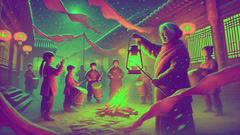
Meanwhile, in her tiny cottage at the edge of the village, Granny Lin sat hunched over her tea, unmoved by the storm of chaos outside. She’d lived through decades of New Year’s Eves and had seen enough to notice patterns others missed. When she heard the beast’s cry echoing through the bamboo, she remembered an ancient tale her grandmother once whispered. In it, Nian was not born evil but was a creature of cold and darkness, driven out of the mountains by hunger and fear of fire. It hated loud noises, bright colors—especially red—and anything that reminded it of the sun.
As dawn neared, Granny Lin made her way through the battered village, searching for survivors. She found Wei, eyes wide with questions, outside the wreckage of his family’s barn. Without a word, she handed him a piece of red cloth, her voice low but sure: “There’s power in this color. Hang it high and let it dance in the wind. And if you can find something to make noise—anything—do it with all your heart.”
Wei ran to his friends, relaying Granny Lin’s words. The children scrambled to gather red scarves, scraps of cloth, and even tattered festival banners that had survived the night. They hung them from windows, tied them around the necks of frightened goats, and draped them across doors. Others found pots, pans, gongs, and even hollow bamboo stalks—anything that could make a racket.
By midday, the village was a wild sea of red and noise. Nian, already sated from its midnight feast but still prowling for easy prey, returned to the edge of the fields. It crept closer, drawn by instinct. But as it neared, a sudden clamor rose up—a cacophony of shouts, banging metal, and drumbeats. The red banners snapped in the wind, filling the air with a fluttering brilliance. Nian paused. For the first time, its eyes showed something like uncertainty.
The beast retreated, inch by inch, until it vanished once more into the depths of the forest. The villagers watched in disbelief and then erupted in laughter, relief mingling with triumph. They’d discovered the key to keeping Nian at bay: courage, wisdom, and a little bit of noise.
A New Dawn: The Birth of Tradition
With Nian gone, the villagers emerged from hiding, blinking in the pale winter sunlight. For the first time in memory, the end of New Year’s Eve brought not only survival but joy. The children ran from house to house, boasting of their bravery and the power of red. Parents set out feasts, sharing rice cakes and sweet dumplings as if they’d never known hunger. In the center of the village, Granny Lin was hailed as a hero, though she waved off the praise with a wink and a crooked smile.
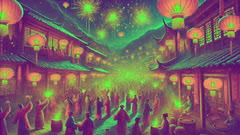
But as dusk approached, anxiety crept back in. What if Nian returned? Would red banners and noisy drums be enough next year? Wei, ever curious and restless, spent the following days searching for ways to make their new defenses stronger. He wandered through the market, seeking objects that could make even louder sounds. He watched as traders from distant provinces lit long strings of bamboo that cracked and popped in rapid succession. The merchants called them “pao”—bamboo firecrackers. Wei’s eyes lit up. If noise alone scared Nian, then surely these fiery explosions would keep it away for good.
As spring neared and travelers began their journeys again, Wei bartered for a bundle of firecrackers. He gathered his friends and together, under Granny Lin’s watchful gaze, they tested them in an open field. The explosions echoed through the valley, startling birds from the treetops and sending every village dog into a frenzy. But most importantly, when night fell and Nian’s shadow loomed once more at the edge of the forest, the beast hesitated. With a chorus of children banging pots and a rain of firecrackers lighting the sky, Nian fled in terror, its howls fading into the night.
A tradition was born. Every year, as the lunar calendar marked another cycle, the village erupted in a festival of color and sound. Houses were adorned with red banners, lanterns glowed from every doorway, and the night air was filled with laughter, music, and the thunder of firecrackers. Nian never returned. Word spread from valley to valley, mountain to mountain, until all of China celebrated with red and noise to keep misfortune at bay.
Yet in Xiyuan, people remembered. They honored Granny Lin’s wisdom and Wei’s courage with a place in every festival. The legend of Nian became not just a tale of fear but a story of hope, unity, and the power of community to transform darkness into light. And so, each New Year’s Eve, as the first firework blossomed above the mountains, every villager looked to the sky—not with fear, but with joy.
Conclusion
The story of Nian is woven into every thread of Chinese New Year: in the crackle of fireworks, the flutter of red banners, and the laughter that chases away winter’s chill. What began as a tale of terror grew into a celebration of courage and community. The villagers of Xiyuan didn’t just defeat a monster—they created a living tradition that would echo through centuries. Every year, as families reunite and towns are cloaked in red, they pay silent tribute to the cleverness of Granny Lin, the daring of Wei, and the spirit that turned fear into festivity. In these rituals—hanging lanterns, sharing sweet dumplings, igniting firecrackers—lies a promise: that together, even in the darkest times, people can overcome what frightens them most. The legend of Nian reminds us that true strength is found not in walls or weapons, but in wisdom, unity, and the courage to face a new dawn.



